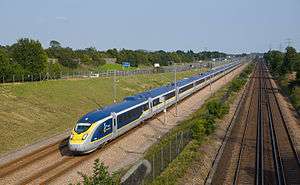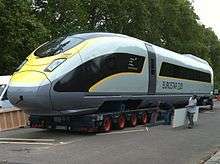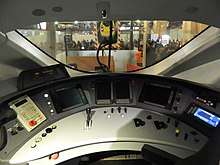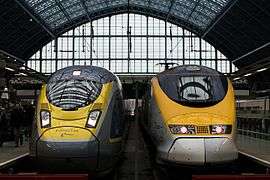British Rail Class 374
| British Rail Class 374 Eurostar e320 | |
|---|---|
 374008/374007 on High Speed 1 | |
| In service | 20 November 2015 - present |
| Manufacturer | Siemens |
| Family name | Velaro |
| Constructed | 2011–2015 |
| Number under construction | 4 trainsets |
| Number built | 13 trainsets |
| Formation | 16 cars |
| Capacity | 902 seats[1] |
| Operator(s) | Eurostar |
| Specifications | |
| Car body construction | Aluminium |
| Train length | 400 metres (1,312 ft 4 in) |
| Car length | 25.7 metres (84 ft 3 3⁄4 in) (Leading) 24.2 metres (79 ft 4 3⁄4 in) (Trailing) |
| Maximum speed | 320 km/h (200 mph) |
| Power output | 16 MW (21,000 hp) |
| Power supply | (?) |
| Electric system(s) |
25 kV 50 Hz AC 15 kV 16.7 Hz AC 3000 V DC 1500 V DC Overhead lines |
| Current collection method | Pantograph |
| UIC classification | Bo′Bo′+2′2′+Bo′Bo′+2′2′ +2′2′+Bo′Bo′+2′2′+Bo′Bo′+Bo′Bo′+2′2′+Bo′Bo′+2′2′ +2′2′+Bo′Bo′+2′2′+Bo′Bo′ |
| Track gauge | 1,435 mm (4 ft 8 1⁄2 in) standard gauge |
The Class 374[2] electric multiple unit high speed train, branded as Eurostar e320, provide Eurostar services through the Channel Tunnel to serve destinations beyond the core routes to Paris and Brussels. They began to run passenger services in November 2015.[3] The trains owned by Eurostar International Limited are sixteen-carriage variants of the Siemens Velaro, each measuring 400 metres long. The trains are designed to be compliant with the Technical Specifications for Interoperability (TSI) and the original order for ten sets was subsequently increased to seventeen sets in November 2014.[4]
Eurostar International's existing fleet of Class 373 "Eurostar e300" trains, which date from the opening of the Channel Tunnel in 1994, cannot operate under the 15 kV AC overhead line (OHLE) electrification system used in Germany, most cannot operate under the 1.5 kV DC overhead line (OHLE) electrification system used in the Netherlands and they do not have sufficient space to install ERTMS signalling. As a result, Eurostar is unable to use its Class 373 units on services to these countries, and the Class 374 was designed and built to overcome this problem, and enable Eurostar to journey to these locations. The Class 374 has replaced the majority of Class 373s as of June 2018.
Development

Siemens Velaro high speed EMUs are derived from the ICE 3 first used by Deutsche Bahn (DB) in 2000. Variants include DB Class 407, intended for international services including through the Channel Tunnel.[5]
In 2009, Eurostar announced a £700m project to update its fleet, with approximately £550m for new trains able to operate away from the core London-Paris/Brussels network.[6] In October 2010, Eurostar announced that Siemens had been selected, with the Velaro platform to be used. The Velaro e320, named because of plans to operate at 320 km/h (200 mph), would be 16 cars long, to meet the Channel Tunnel safety specifications but would have distributed traction with the traction equipment along the length of the train, not concentrated in power cars at each end.[7]
Alstom litigation
The nomination of Siemens saw it break into the French high-speed market, as all French and French subsidiary high-speed operators up to that point used TGV derivatives produced by Alstom.[8] Alstom attempted legal action to prevent the contract, claiming that the Siemens sets would breach Channel Tunnel safety rules,[9] but this was thrown out of court.[10] Alstom said that it would "pursue alternative legal options to uphold its position", and on 4 November 2010 it lodged a complaint with the European Commission over the tendering process, which then asked the British government for "clarification".[11] Alstom then announced it had started legal action against Eurostar in the High Court in London.[12] In July 2011, the High Court rejected Alstom's claim that the tender process was "ineffective",[13] and in April 2012 Alstom said it would call off pending court actions against Eurostar.[14]
Construction and delivery

The trains were constructed at the Siemens plant at Krefeld in Germany,[4] with the first rolled out for testing at the Wildenrath test circuit in early 2013[15] as Class 374, with the first unit bearing this UIC identification mark.[2] The intention was for the first unit to enter service in 2014, but the approval was delayed. As a consequence, Eurostar did receive its first unit in 2014 for presentation but operation could only start a year later.[16]
At the presentation of the first train in London in November 2014, Eurostar announced that they had ordered 7 additional train sets, and that the first e320 service would be at the end of 2015.[17] By November 2014 nine of the 10 trains had been built and all 10 were scheduled to be delivered by April 2016.[17] The seven trains in the second order will be delivered by March 2018.[18]
Testing

By April 2013 testing had started at Siemens Mobility's test and validation centre, Wegberg-Wildenrath.
On 27 January 2014 set 4007+4008 was hauled across Belgium by B-Logistiks' TRAXX E 186 199,[19] and on the night of 29/30 January 2014 was dragged by Eurotunnel Class 0001 rescue locomotives via the Channel Tunnel and High Speed 1 to Temple Mills Depot where it arrived at 01:41:30 on 30 January 2014.[20][21][22]
As of July to August 2014, tests were carried out on the LGV Nord line near Lille. The end of 2014 saw testing of one set on the LGV Est due to its higher line speed of 320 km/h.
The French Railway Safety Board (EPSF) granted an authorisation to run the train in France on 16 October 2015; the approval for operating though the Channel Tunnel was granted on 19 November by the Intergovernmental Commission (IGC).[23] At the beginning of January 2016 the Belgian authority SSICF authorized the operation in its country.[24]
Operations

Eurostar intend to use the trains to expand its core operation between London St Pancras International, Paris Gare du Nord and Brussels Midi/Zuid. To meet the prospect of increased competition through the Channel Tunnel (primarily from DB), it intends to use them to expand its network to Amsterdam, Frankfurt and Cologne, and more destinations in France.[25] In September 2013, Eurostar announced that its new service between London and Amsterdam, intended to begin operation in December 2016, would be operated by the trains.[26] In April 2016 Eurostar said that the Amsterdam service was now planned to operate from late 2017.[27] The first Class 374 set entered service in November 2015, ahead of the full launch of the new type; the receipt of the safety authorization from the Intergovernmental Commission was received earlier than expected, allowing Eurostar to begin utilizing the type on a small number of services for in-service testing.[28]
Early 2018 the tracks and international platforms at Ashford International underwent a £10-million refurbishment to allow compatibility with Eurostar's e320 class 374 trains from the 1st of April[29]. Unfortunately, the unit is still not compatible today, so no one is able to stop at the station[30]. So far only one e320, the one with the Secretary of State for Transport Chris Grayling, called at Ashford International, Network Rail wrongly stated that "the project has been delivered by Network Rail"[31], but indeed it is not yet delivered and there is no date for it.
Fleet details
The carriages are numbered in half-sets of eight-vehicles as 93 70 3740 NNN-N GB-EIL, where 93 denotes high-speed EMU, 70 denotes Great Britain, 374 is the class, 40NN (sharing the 4 from the class 374) is the unit number followed by a single digit for each carriage counting from the driving car towards the centre, a check digit, GB for Great Britain and EIL for Eurostar International Limited.
| Class | Units | Operator | No. built | Year built | Cars per set | Services operated |
|---|---|---|---|---|---|---|
| Class 374 | 4001–4020[uic 1] | Eurostar | 10 (20 half-sets) | 2011–2013 | 16 | London-Paris/Brussels/Amsterdam[32] |
| 4021–4034 | 7 (14 half-sets) | 2016–2018 |
- ↑ 93 70 3740 021–8 GB-EIL, 93 70 3740 022–6 GB-EIL, 93 70 3740 023–4 GB-EIL, 93 70 3740 024–2 GB-EIL,93 70 3740 025–9 GB-EIL, 93 70 3740 026–7 GB-EIL, 93 70 3740 027–5 GB-EIL, 93 70 3740 028–3 GB-EIL plus 93 70 3740 018–4 GB-EIL, 93 70 3740 017–6 GB-EIL, 93 70 3740 016–8 GB-EIL, 93 70 3740 015–0 GB-EIL, 93 70 3740 014–3 GB-EIL, 93 70 3740 013–5 GB-EIL, 93 70 3740 012–7 GB-EIL, 93 70 3740 011–9 GB-EIL.
Each set is formed of 16 coaches:
| Coach | Description | Seating | |||
|---|---|---|---|---|---|
| 1st | 2nd | Toilets | Baby changing | ||
| 1 | Standard Premier/Business Premier | 40 | - | - | - |
| 2 | Standard Premier/Business Premier | 36 | - | 2 | 1 |
| 3 | Standard Premier/Business Premier | 33+2 | - | 1(D) | - |
| 4 | Standard Class | - | 76 | 2 | 1 |
| 5 | Standard Class | - | 76 | 2 | 1 |
| 6 | Standard Class | - | 76 | 2 | 1 |
| 7 | Standard Class | - | 76 | 2 | 1 |
| 8 | Standard Class/Bar-Buffet | - | 32 | 2 | 1 |
| 9 | Standard Class/Bar-Buffet | - | 32 | 2 | 1 |
| 10 | Standard Class | - | 76 | 2 | 1 |
| 11 | Standard Class | - | 76 | 2 | 1 |
| 12 | Standard Class | - | 76 | 2 | 1 |
| 13 | Standard Class | - | 76 | 2 | 1 |
| 14 | Standard Premier/Business Premier | 33+2 | - | 1(D) | - |
| 15 | Standard Premier/Business Premier | 36 | - | 2 | 1 |
| 16 | Standard Premier/Business Premier | 40 | - | - | - |
See also
References
- ↑ UK, DVV Media. "Eurostar orders seven more e320s".
- 1 2 "New Class 374 Eurostar on test". Today's Railways. Platform 5 (134): 15. 2013.
- ↑ "Eurostar Velaro e320 enters passenger service". International Railway Journal. Retrieved 13 January 2017.
- 1 2 "Eurostar unveils new 200mph Channel Tunnel train". Daily Telegraph. London. 13 November 2014. Retrieved 13 November 2014.
- ↑ "DB unveils next-generation ICE". Railway Gazette International. London. 29 April 2010. Retrieved 15 April 2013.
- ↑ "Eurostar considering larger fleet?". Railway Gazette International. London. 6 April 2009. Retrieved 15 April 2013.
- ↑ "Eurostar picks Velaro to expand fleet". Railway Gazette International. London. 1 October 2010. Retrieved 2 October 2010.
- ↑ Wright, Robert (1 October 2010). "Row breaks out over Eurostar train order". Financial Times. London. Retrieved 1 October 2010.
- ↑ Wright, Robert (19 October 2010). "Alstom heads for court over Eurostar trains". Financial Times. London.
- ↑ "Alstom fails to block Eurostar contract". International Railway Journal. London. 30 October 2010. Archived from the original on 1 November 2010. Retrieved 30 October 2010.
- ↑ "Alstom lodges Eurostar complaint in Brussels". Financial Times. London. 4 November 2010. Retrieved 11 November 2010.
- ↑ Wendlandt, Astrid (11 November 2010). "Alstom says Eurostar tender hearing in Oct 2011". Reuters. Retrieved 11 November 2010.
- ↑ Milmo, Dan (15 July 2011). "Siemens keeps €600m Eurostar order after Alstom legal challenge fails". The Guardian. London. p. 29. Retrieved 15 August 2012.
- ↑ Topham, Gwyn (3 April 2012). "Alstom drops Eurostar legal action after SNCF orders more trains". The Guardian. London. Retrieved 15 August 2012.
- ↑ Nigel Wordsworth (2013-10-13). "New Eurostar under test". RailEngineer. Retrieved 2016-02-08.
- ↑ "New Eurostars delayed?". Today's Railways. Platform 5 (137): 15. 2013.
- 1 2 "Eurostar to order more e320 high-speed trains". Rail News. 2014-11-13. Retrieved 2016-02-08.
- ↑ "FAQs, THE OPERATIONAL SIDE". Eurostar4agents. Eurostar International Limited. Archived from the original on 25 January 2016. Retrieved 25 January 2016.
- ↑ "First Eurostar Velaro Arrives in Britain". Railvolution. 28 January 2014. Retrieved 2 March 2014.
- ↑ Adam. "6K74 Eurotunnel Boundry to Templemills Depot New Eurostar Delivery No 374 007 with 2 Krupps" (video). YouTube. Retrieved 21 March 2014.
New Eurostar Delivery. 374 007 with 2 Krupps
- ↑ Howard. "2 Krupps Locos Drag The Brand New E320 Eurostar 4007/8 Through Ebbsfleet International – 30/1/14" (video). YouTube.
0040 on the 30/1/14 … re-scheduled to run overnight in the same path the next day. Here are 2 Krupps locos dragging the brand new Velaro E320 Eurostar through Ebbsfleet International working 6K74 Eurotunnel Boundary – Temple Mills Depot. Unit numbers were 374007/008
- ↑ "629X 2332 Eurotunnel Boundary (Ctrl) to Temple Mills Recp". Realtime Trains. 29 January 2014. Retrieved 2 March 2014.
Eurotunnel Boundary (Ctrl) WTT: 2332 Realtime: 2243 (49E); Temple Mills Recp WTT: 0150 Realtime: 0141½ (8E)
- ↑ Keith Barrow (20 November 2015). "Eurostar Velaro e320 enters passenger service". IRJ International Railway Journal. Archived from the original on 25 January 2016. Retrieved 8 February 2016.
- ↑ Belga News (2016-01-15). "Les nouveaux trains Eurostar autorisés à circuler en Belgique". RTBF Info (in French). RTBF. Retrieved 2016-01-25.
- ↑ Odell, Mark (13 May 2012). "Eurostar eyes expansion across Europe". Financial Times. London.
- ↑ "Eurostar to run London-Amsterdam services from 2016". Global Rail News. 27 September 2013. Retrieved 1 October 2013.
- ↑ "Eurostar undertakes detailed planning for London – Amsterdam service".
- ↑ "Eurostar e320 enters service". Railway Gazette. 20 November 2015. Retrieved 20 November 2015.
- ↑ "Ashford International modified for use by Eurostar e320 trainsets". Railway Gazette. 19 January 2018. Retrieved 19 January 2018.
- ↑ "Eurostar e320 trains still can't stop at Ashford International four months on". Ken Online. 7 August 2018. Retrieved 1 September 2018.
- ↑ Network Rail (3 April 2018). "Ashford station's international future looks bright as first modern high-speed train calls en-route to Paris [and Brussels]". Retrieved 1 September 2018.
- ↑ "It's a knockout!". www.railmagazine.com. 2018-01-24. Retrieved 2018-06-14.
External links

- Specification Sheet
- Virtual visit of the Class 374 interior